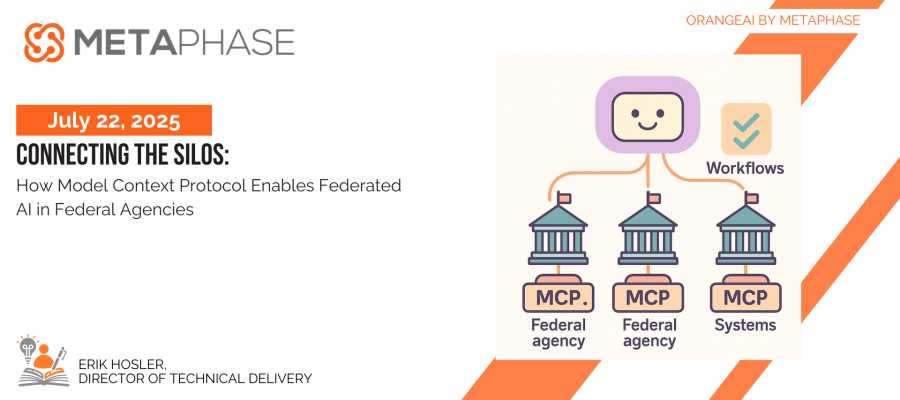
In the age of AI, access alone is not enough. What if every federal employee could tap into a shared brain tailored to their mission, compliant by design, and trained on the tools they use every day?
Despite the emergence of generative AI across the federal government, most agencies still operate in digital isolation. Current AI capabilities are often limited to basic chat interfaces wrapped around large language models and are typically deployed as standalone experiments. These tools are bolted onto systems that are already fragmented and siloed. The result is a patchwork of innovation that rarely scales across enterprise environments. The real promise of AI in the public sector lies not in more models, but in more context. That context must be delivered securely, consistently, and collaboratively.
This is where the Model Context Protocol, or MCP, becomes foundational.
MCP is an open, vendor-neutral protocol that allows AI agents to share context, invoke tools, and interact with systems in a standardized and compliant way. It is not a new model or platform. Instead, it provides a common communication method that lets agents plug into a shared ecosystem of capabilities. Each implementation of MCP connects an agent to "MCP servers" that expose functions such as search, document summarization, workflow automation, or knowledge retrieval. These MCP servers can be developed by different vendors and tailored for different agency needs. The result is modular and scalable. AI agents are no longer limited to one system or tool, and they can operate with more autonomy and relevance.
This shift unlocks a fundamentally new capability. Take the example of a federal caseworker. Today, that individual might navigate multiple applications to retrieve records, interpret policy guidance, and generate communications. With MCP-enabled agents, the caseworker is supported by an assistant that maintains memory across sessions, retrieves the correct tools, and automates repetitive tasks like document generation or appointment scheduling. This is not just AI chat. It is embedded, context-aware workflow support.
The power of MCP grows even more in cross-agency scenarios. Imagine Agency 1 needs to procure cybersecurity services using acquisition vehicles owned and managed by Agency 2. Currently, this process relies on duplicative systems, lengthy coordination, and repeated data entry. With MCP, an AI agent in Agency 1 can interact directly with Agency 2's MCP server. It can access contract availability, check compliance thresholds, and generate draft acquisition documentation. All of this happens without transferring raw data. Instead, agents exchange context and logic. The result is secure, inter-agency collaboration driven by AI, not hindered by bureaucratic fragmentation.
These capabilities are especially critical as the federal government explores how to scale generative AI responsibly. Most agency environments today are early in their AI maturity. Use is typically constrained to pilot chat applications, often without persistent memory or tool integrations. MCP offers a roadmap to move beyond pilots. It enables the secure orchestration of AI across mission systems, policy engines, and enterprise tools.
Of course, MCP also introduces new considerations. AI systems operating in live environments must respect permissions, auditability, and identity roles. Many agencies still restrict AI tools due to legitimate concerns over data protection, misuse, and regulatory ambiguity. For MCP to succeed, it must be introduced through deliberate pilots in controlled, non-production environments. These pilots provide the evidence base for policy development. They surface edge cases, validate safeguards, and demonstrate how risk can be mitigated with structure, not avoidance.
The broader AI research community is also beginning to validate MCP's value. Multi-agent studies show that shared context protocols can reduce redundancy and improve coordination by over 50 percent. Emerging vendor ecosystems are adopting MCP-compatible standards, and organizations like OpenAI, Microsoft, and Anthropic are building frameworks to align with MCP principles. This trend is reinforcing the need for common AI infrastructure particularly in complex, security-sensitive environments like the federal government.
MCP is not a product. It is an architecture. It defines how agents work across environments, access tools, and preserve continuity. Most importantly, it enables federal agencies to scale AI responsibly while maintaining mission alignment and compliance.
MetaPhase’s Value
MetaPhase is uniquely positioned to guide this transformation. Through our Mpowered™ Intelligence Integration Framework and OrangeGPT accelerator, we have the tools to help agencies implement secure, scalable GenAI solutions tailored for mission success. By combining domain-specific context, secure orchestration layers, and compliance-first architectures, MetaPhase empowers agencies to explore what’s next without compromising what matters.

